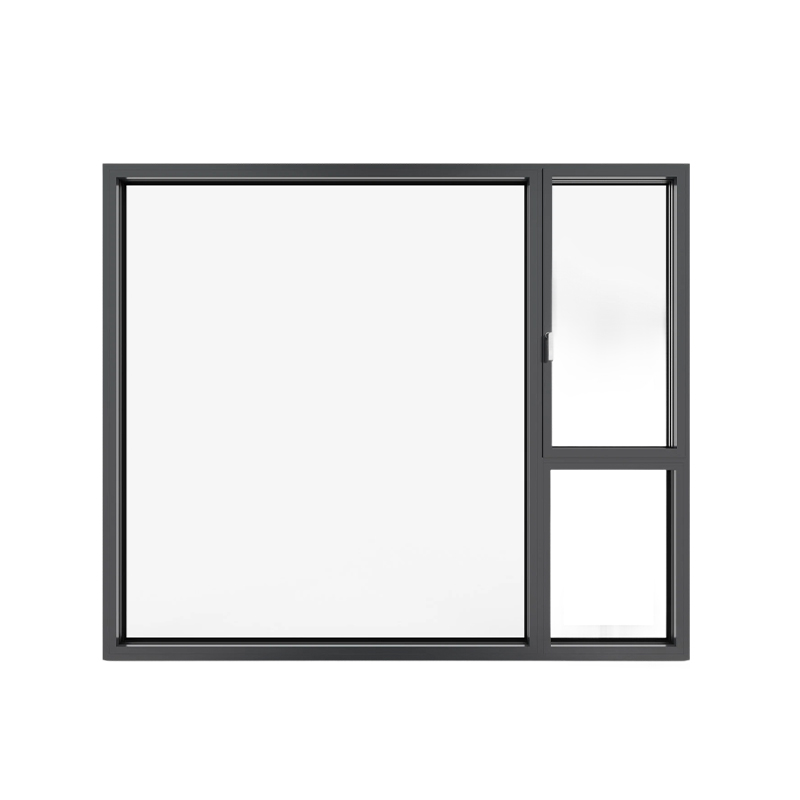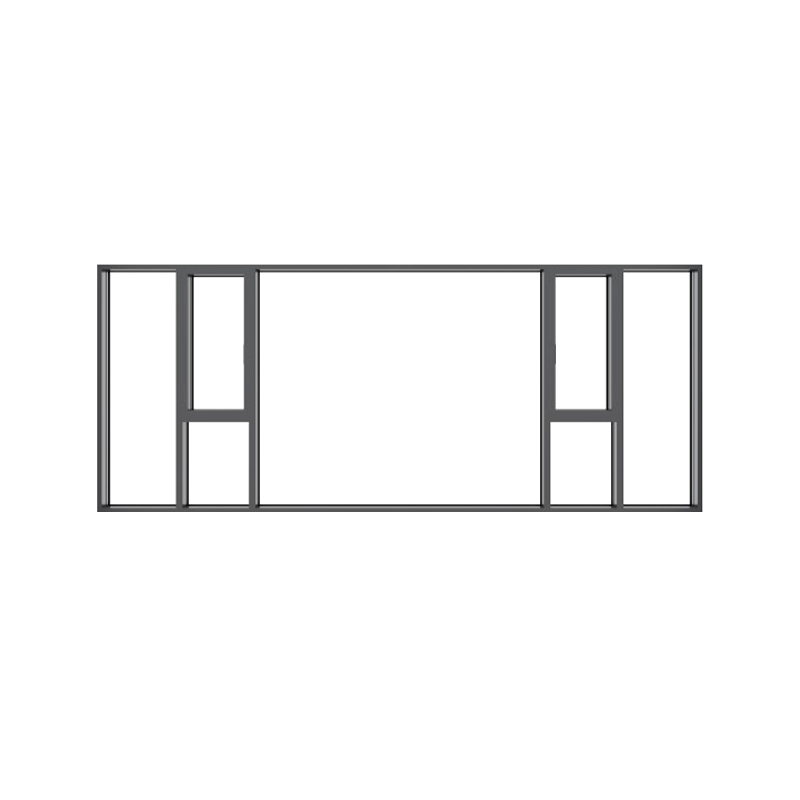How do low energy consumption inward opening windows achieve a dual breakthrough in energy saving and performance?
Release Time : 2025-11-06
In today's increasingly stringent building energy efficiency standards, windows, as the weakest link in the building envelope in terms of thermal performance, are transforming from traditional "lighting and ventilation openings" into key nodes determining building energy efficiency. Low energy consumption inward opening windows—especially those built using high-performance aluminum alloy system window technology—are redefining modern green building expectations for windows through their precise structural design, advanced thermal insulation technology, and strict airtightness and watertightness control. They are not only about the smooth opening and closing of a window, but also about the energy consumption level, indoor comfort, and even the carbon footprint of the entire building.
The core of low energy consumption inward opening windows lies in effectively blocking the unintended transfer of heat through the window structure. Traditional aluminum alloy profiles have high thermal conductivity, easily forming "thermal bridges," leading to heat loss in winter and heat wave intrusion in summer. Modern low energy consumption inward opening windows employ "thermal bridge breaking" technology, embedding high-strength polyamide thermal insulation strips between the inner and outer aluminum profiles to form a continuous thermal barrier layer. This seemingly simple structural innovation actually requires precise calculations of the thermal break strip width, cavity layout, and material expansion coefficient matching to ensure no stress deformation or sealing failure occurs under temperature changes. High-end system windows even employ multi-cavity composite thermal break structures to further reduce the overall window heat transfer coefficient, approaching the stringent standards of passive houses.
The choice of low-energy-consumption inward-opening windows is not accidental, but rather the result of comprehensive performance optimization. Compared to outward-opening windows, which are susceptible to wind and rain erosion and pose a risk of falling from heights, inward-opening windows place the hardware and sealing system on the indoor side, extending their service life and simplifying maintenance. More importantly, the inward-opening structure is naturally suited to multi-layer sealing designs—typically including three or even four sealing strips based on the principle of equal pressure chambers, each responsible for windproofing, waterproofing, airtightness, and thermal insulation. When the window sash is closed, the multi-point locking system applies pressure evenly, ensuring full adhesion of the sealing strips, achieving airtightness and watertightness far exceeding national standards, effectively preventing cold air infiltration and rainwater backflow, significantly improving winter heating and summer cooling efficiency.
Glass configuration is also a key factor in low energy consumption. Professional system windows generally use double- or triple-silver Low-E insulated glass, filled with argon or krypton gas, and use warm edge spacers instead of traditional aluminum spacers to comprehensively suppress heat transfer through radiation, conduction, and convection. The U-value (heat transfer coefficient) and SHGC (solar heat gain coefficient) of the entire window can be precisely adjusted according to the regional climate—high insulation and low U-value are emphasized in cold regions, while shading and lighting are balanced in hot-summer and warm-winter regions, achieving "on-demand energy saving."
It is worth mentioning that low energy consumption inward opening windows do not come at the expense of performance. High-quality aluminum alloy system inward opening windows pursue energy saving while also considering wind pressure resistance, sound insulation, durability, and aesthetics. 6060-T66 high-precision aluminum ensures profile strength and surface flatness; a concealed drainage system achieves a balance between a simple appearance and reliable function; and the surface treatment uses fluorocarbon spraying or powder coating, providing weather resistance for over 20 years. All components—from profiles and sealing strips to hardware—are developed collaboratively according to a systematic approach, rather than simply assembled, ensuring that the overall window performance is greater than the sum of its parts (1+1>2).
Ultimately, a truly low-energy-consumption inward-opening window is the culmination of building physics, materials science, and precision manufacturing. It stands silently within the wall, yet continuously reduces the building's burden—reducing energy consumption, carbon emissions, and reliance on air conditioning and heating. Driven by dual-carbon goals, such windows are not merely building components, but a silent promise of green living: allowing natural light to gently stream in, providing comfortable warmth and coolness, and making energy conservation an everyday, imperceptible elegance.
The core of low energy consumption inward opening windows lies in effectively blocking the unintended transfer of heat through the window structure. Traditional aluminum alloy profiles have high thermal conductivity, easily forming "thermal bridges," leading to heat loss in winter and heat wave intrusion in summer. Modern low energy consumption inward opening windows employ "thermal bridge breaking" technology, embedding high-strength polyamide thermal insulation strips between the inner and outer aluminum profiles to form a continuous thermal barrier layer. This seemingly simple structural innovation actually requires precise calculations of the thermal break strip width, cavity layout, and material expansion coefficient matching to ensure no stress deformation or sealing failure occurs under temperature changes. High-end system windows even employ multi-cavity composite thermal break structures to further reduce the overall window heat transfer coefficient, approaching the stringent standards of passive houses.
The choice of low-energy-consumption inward-opening windows is not accidental, but rather the result of comprehensive performance optimization. Compared to outward-opening windows, which are susceptible to wind and rain erosion and pose a risk of falling from heights, inward-opening windows place the hardware and sealing system on the indoor side, extending their service life and simplifying maintenance. More importantly, the inward-opening structure is naturally suited to multi-layer sealing designs—typically including three or even four sealing strips based on the principle of equal pressure chambers, each responsible for windproofing, waterproofing, airtightness, and thermal insulation. When the window sash is closed, the multi-point locking system applies pressure evenly, ensuring full adhesion of the sealing strips, achieving airtightness and watertightness far exceeding national standards, effectively preventing cold air infiltration and rainwater backflow, significantly improving winter heating and summer cooling efficiency.
Glass configuration is also a key factor in low energy consumption. Professional system windows generally use double- or triple-silver Low-E insulated glass, filled with argon or krypton gas, and use warm edge spacers instead of traditional aluminum spacers to comprehensively suppress heat transfer through radiation, conduction, and convection. The U-value (heat transfer coefficient) and SHGC (solar heat gain coefficient) of the entire window can be precisely adjusted according to the regional climate—high insulation and low U-value are emphasized in cold regions, while shading and lighting are balanced in hot-summer and warm-winter regions, achieving "on-demand energy saving."
It is worth mentioning that low energy consumption inward opening windows do not come at the expense of performance. High-quality aluminum alloy system inward opening windows pursue energy saving while also considering wind pressure resistance, sound insulation, durability, and aesthetics. 6060-T66 high-precision aluminum ensures profile strength and surface flatness; a concealed drainage system achieves a balance between a simple appearance and reliable function; and the surface treatment uses fluorocarbon spraying or powder coating, providing weather resistance for over 20 years. All components—from profiles and sealing strips to hardware—are developed collaboratively according to a systematic approach, rather than simply assembled, ensuring that the overall window performance is greater than the sum of its parts (1+1>2).
Ultimately, a truly low-energy-consumption inward-opening window is the culmination of building physics, materials science, and precision manufacturing. It stands silently within the wall, yet continuously reduces the building's burden—reducing energy consumption, carbon emissions, and reliance on air conditioning and heating. Driven by dual-carbon goals, such windows are not merely building components, but a silent promise of green living: allowing natural light to gently stream in, providing comfortable warmth and coolness, and making energy conservation an everyday, imperceptible elegance.







